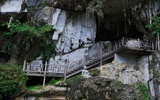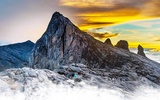Bako National Park is very popular for treks and trails, wildlife spotting and birding. Bako also has tranquil white sandy beaches that are perfect resting spots in between jungle treks. There are 16 color-coded jungle trails to choose from based on different levels of fitness. The fit and adventurous can opt for full-day jungle hikes or overnight camping and trekking, while those who prefer a leisure trek can opt for a relaxing forest walk.
Jungle Trek and Nature Trails
Paku trail is relatively flat, short and easy. It offers one of the best opportunities to see the park's wildlife. The trail finishes at a beach which is home to a colony of proboscis monkeys living in the trees above.
Tajor trail takes you through a varied terrain, including hilltops with great views. The trail ends at a small but attractive waterfall. The calm pools and waterfall are safe for swimming.
Limau trail is a continuation from Tajor trail. It is the park's longest and most arduous trek. After 5 – 7 hours of trekking, the trail ends on a beach and it's possible to arrange to be picked up by boat from the Limau beach. Please take note to inform the park staff about trekking Limau or Kruin trail.
Lintang trail is a loop trail taking you through all the park's different types of vegetation in half a day.
Hike to See the Sea Stack
Telok Pandan Kecil is Bako’s best beach. Hike along Telok Pandan Kecil trail for around an hour to come to a rocky headland. From there, take in the beautiful view of a beautiful secluded bay. The beach is bordered by limestone and sandstone cliffs, and the erosion from the waves, leave remarkable rock formations, such as the famous Sea Stack. Alternatively, you can hire a boat from one of the beaches in the park to see the Sea Stack up close.
Wildlife Spotting
Telok Assam is located near Bako National Park HQ and is a great place for spotting wildlife such as the long-tailed macaques, silver leaf monkeys, monitor lizards, plantain squirrels, bearded pigs and mouse deer.
Although it requires some patience, an encounter with a group of proboscis monkeys is likely to be the highlight of your trip to Bako. The best times to see them are early in the morning or in the hours before dusk. Telok Delima and Telok Paku are the best trails for viewing the proboscis as well as the mangroves at Telok Assam. Telok Assam is also an excellent bird watching spot.
Watch the Sunset
Take a stroll at sunset on Telok Assam beach and you will see flocks of swifts hovering around their nests at the rocks of the beach. Watch the sunset over Mount Santubong, providing a colourful backdrop to the mountain.
Birding
Bako is also a great place for birdwatching. There are 53 species endemic to the island of Borneo, but over 150 bird species have been spotted in this park. Some of the highlighted species includes Kingfishers, Barbets and Woodpeckers.
Night Walk to Spot Nocturnal Wildlife
If you stay a night in Bako National park, it is recommended to join the night walk led by park rangers trained in spotting creatures that we would otherwise walk right by. It is thrilling to spot flying lemurs, snakes, stick insects, pit vipers and more in their natural habitat.
Island Trip to Pulau Lakei
Pulau Lakei is a small island with a wonderful white sand beach and small guard house. Located near the northern tip of the Bako National Park, trips to the island can be arranged with a boatman. The boat journey takes approximately one hour and on the way, you will see the beautiful rock formations and sea stacks. Apart from the beach, there is a wooden staircase with more than 150 steps that leads to the highest point of the island - a natural pool called Kolam Salamun with mysterious calligraphy and a view point that sits atop a steep cliff giving visitors an absolutely stunning vista.
Take a Cruise to Get Up Close to the Sea Stacks
You can hire a boat to see the famous giant sea stacks of Bako found at Teluk Pandan Kecil and along the coastline. These natural sandstone formations are often larger in real life than in pictures. The most prominent one just several metres out of the sea resembling the head of a cobra. There is also a unique sandstone formation resembling the head of a laughing lion.

